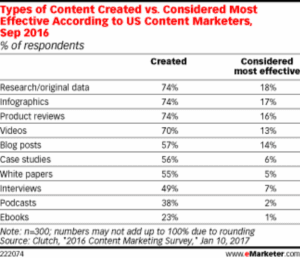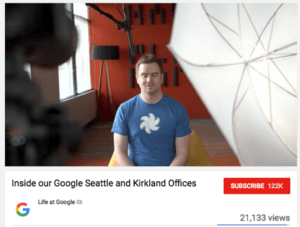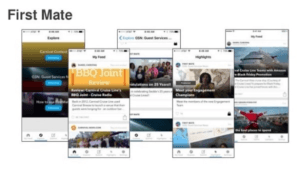Content marketing is one of the most effective forms of marketing today because the competition for consumer attention has increased significantly, while a customer’s tolerance for disruptive messaging has diminished. With these seven methods, your company can utilize other business-related functions as content marketing opportunities to improve the organization’s overall marketing strategy.
“More than just a buzzword, content marketing has become one of the most powerful tools for attracting targeted customers, building loyalty and driving profitability,” says Veronica Stoddart, the principal of VS Content Strategies and former travel editor of USA TODAY.
“If done right and properly integrated within a brand, content marketing will benefit a cross-section of departments, including marketing, sales, public relations and even customer relations.”

Seventy-four percent of surveyed B2B executives created content with original data and research as they found it to be the most effective marketing tactic in their toolkit.
Long-term success with content marketing comes with integrating the practice company-wide. Marketing should still direct all efforts with content, but partner with different departments to best inform their use of content on behalf of the brand.
Here are seven ways your organization should consider integrating content marketing across departments.
1. Humanizing HR
Beyond tracking vacation time and handing out employee guidelines, the human resources department should be responsible for creating a supportive company culture.
HR can use content to let prospective applicants understand the values that the company stands for, what it’s like to work at the brand and illustrate what benefits employment offers.
Too often HR isn’t equipped to create and distribute content to support their goals.
“Content creation often exists in a bubble, and to have a successful content strategy, every department should have the permissions and expectations to be part of the process,” says Kim Yuhl, an award-winning business storyteller and founder of Better Brand Stories. “This happens when there is a clear brand story and it’s known, celebrated, and shared throughout the organization.”
Marketing should partner closely with HR to train the department on how to best create content about company culture-related topics and establish what the purpose is behind the brand. While most HR reps probably won’t have a writing background, they can still be trained to create fun and engaging content through emails and IM channels. For example, with any company announcement, the HR rep can make it a colorful read for employees, instead of just a bullet-point list with the new rules or announcements. These can then be repurposed as public-facing content, right at home on professionally geared social platforms such as LinkedIn.
Clearly knowing how the organization and their values came into existence will not only direct all the content efforts related to HR, but should inform the themes covered in content company-wide.

For example, Google is widely known for cultivating a unique and enticing company culture that attracts quality talent and retains its existing workforce.

Through articles, videos and visuals, the Google team shares stories of what it’s like to work at the brand, what qualities the organization looks for in applicants and profiles of current employees and their personal stories related to the company.
Emulate Google’s approach by allowing employees to share the positive experiences with the company in different formats of content, whether in a podcast interview, a LinkedIn article or anything else in between. Depending on your company’s social media policies, you might even encourage your employees to follow and engage with the company’s page. Allow employees to tag and check-in with your company’s page so that your brand can be distributed that way and speak to your targeted audience.
2. Streamlining Customer Service
Every team that interacts with your customers, directly or indirectly, should be learning to identify content topics worth covering.
“The second problem is that most organizations, and the departments within them, listen to reply, instead of listening to learn,” says Kim Yuhl.
Equip customer service to not only effectively respond to customer issues, but also record and categorize feedback that is worth covering with content.
Forrester found that 72 percent of consumers prefer using a company’s website to answer their questions, which requires a company to create the right content of interest to their audience.
Yet, only half of the customers find the information they are looking for from businesses.
“It’s important to remember that every department has stories to share that will benefit the customer and every voice in the organization must have a seat at the table when planning the best way to share the company’s mission,” adds Yuhl.
When customer service takes the time to listen and report what they’ve learned, they not only inform content to serve the goals of other departments but can create content to streamline their operations. It also proves to the customer that you care enough about their business and goals to effectively research and create relevant content topics for their readers.

Identifying patterns in customer feedback can help customer service develop an FAQ section like American Home Shield, scripts for future customer interactions, blog posts and other content to reference or send to customers to save time dealing with repeat questions. Content that is too basic or repetitive, however, can make for a bad user experience in which the reader won’t get the answers they need. Your customer should have well-thought-out core pages to handle going in depth on the products, services and FAQs. The blog section should give readers hot topics on things happening in that respective industry.
One of the best ways you can help your customer with their content needs is to assist them in developing buyer’s personas. Buyer’s personas are fictional characters that represent the different demographics of potential customers. Creating in-depth personas can help you create and promote content more effectively. Creating personas that circle around each type of person who might be a customer, it can give your content creator a checklist-type pattern workflow. Whoever is creating the topic and performing the keyword research will have to make sure they’re hitting on the marks on the personas wants and needs.
Persona development can be a long process, but makes it worth it. It also proves to your customers that you are trying to get in the head of people who will buy their products and services.
3. Boosting Public Relations
One of the many goals of public relations (PR) is to drive awareness of an organization through increased media coverage on TV, in magazines, across social media, on a popular podcast or elsewhere.
In addition to pitching the media about new products, services and advancements the company is working on, PR should generate attention to top-performing content.
PR shouldn’t promote every blog post, video or podcast episode, but coordinate with marketing to regular identify content that should be featured among a wider audience. Small blurbs or shoutouts through email blasting or social media callouts can help gain even more attention to the blog posts or videos that are already gaining traction with users.

For example, this infographic focusing on healthy foods that improve your sleep was produced by Amerisleep, a mattress company, and originally appeared in an article on their blog.
Because the article with the infographic was driving more traffic and social sharing than usual on the blog, this content was then pitched to different publications to generate additional exposure. Because the company was able to coordinate their PR with the progress of their content marketing, Amerisleep secured coverage in Entrepreneur, Huffington Post, Fox News and DesignTAXI.
Pitching existing content for coverage in industry publications is an effective tactic because the information is focused on providing value to customers as opposed to selling something.
Updating older content can also give PR a chance to repromote the brand. Updating a blog post that did well in the past with newer stats and information can give you a reason to reshare the blog, in hopes of gaining even more visitors. Increase your company’s profile online and offline by coordinating PR and marketing to include existing content into your greater mix of media pitches.
4. Invigorate Internal Communications
Employees are far more engaged in their work when they understand what’s happening at their company and how they contribute to the organization’s goals. One of the best ways of connecting with employees is sharing content personalized to their interests and goals to help keep them informed.
Facilitate the sharing of content internally by opening communication paths between departments to highlight what initiatives are being worked on, successes and failures and what company content currently exists.
“Through collaboration, team members will have some ideas what content is created and by whom,” says Pam Didner, author, speaker and senior marketing consultant at Relentless Pursuit.
“With open channels of communication, there’s a broader awareness of how existing content can be repurposed to serve internal needs; conflict around company messaging is reduced as more stakeholders are aware of what’s happening and more.”

For instance, Carnival Cruises created an app called First Mate to communicate with employees in a more personal and streamlined manner.
Employees can receive relevant notifications on their mobile device about news, content and company updates specific to their interests.
This app is one way for internal communications to distribute and promote company content among employees to keep them up-to-date with company developments, as well as encourage them to share this content with their personal network on social media.
Content can help employees better understand the direction of the company and their part of its growth, which can lead to a more productive workforce engaged in their role.
In addition, Carnival Cruises has 43,000 employees, which is an opportunity for the organization to get in front of a vast audience if staff members are willing to share company content.
An employee’s willingness to share content comes down to its relevance to them, how easy it is to share and their awareness of any guidelines for sharing company content.
Whether you’re using an app or otherwise, communicate with employees using personalized content created specifically for their eyes only or curated from elsewhere.
5. Cultivate C-Suite Thought Leadership
Beyond leading a company to the next stage of growth, an executive also acts as a representative of an organization’s brand.
Consumers more easily connect with people, not brands, which is why many executives take on the role of spokesperson to ensure the company’s messaging resonates online and offline.
Unfortunately, 60 percent of Fortune 500 CEOs don’t have a social media presence to share their viewpoints with consumers because the content process can be time-consuming, requires training to execute correctly and the benefits need to be explained to combat content resistance.
Training executives on the proper way to create and share content is one of the most effective methods for communicating a company’s ideas, values and positioning in the marketplace.
Once an executive actively produces and shares content it can also act as an example for employees on how they should consider creating and distributing useful content.
Develop a strategy for leadership to regularly create authoritative blog posts, videos, social media posts, podcasts or whatever format is best suited to their expertise and your audience. High-ranking employees in your company sharing content can also get your blogs and other content higher authority rankings because people might be more inclined to share on their blog.
Whether an executive is creating content for publishing once a week or once a month, it’s important that it ties back in some way to the interests of the company and their role as a leader.
 For instance, Scott Elser, the CEO of Digital Current, publishes articles on LinkedIn, Inc. and Forbes to share his expertise and humanize his company.
For instance, Scott Elser, the CEO of Digital Current, publishes articles on LinkedIn, Inc. and Forbes to share his expertise and humanize his company.
Elser’s content covers leadership and business practices from his career experiences and gives insight and updates on how to utilize SEO and content marketing.
By sharing his thoughts on relevant subjects, he’s able to cultivate a brand for himself as a leading professional and concurrently build the up-and-coming brand of Digital Current. Again, going back to the method of promoting instead of selling, visitors are more likely to engage with the content, then look into the company’s services and products.
To save time while sharing content, curate the content of others that align with your goals and perspectives. Beth Comstock, the vice chair at General Electric, not only shares content created by her and her team but also curates the content of others on relevant subjects.

As an executive representing General Electric, she’s able to continue to reach her audience with engaging and relevant content but isn’t burdened with creating all of it herself.
Executives should follow other industry experts, blogs, podcasts and media sources to continue to find interesting content related to their focus that’s worth adding commentary to and sharing.
6. Supporting SEO Efforts
Optimizing a website’s pages, building high-quality links and improving page load time are some of the many methods for improving the visibility of a company’s site in search.
The marketing team’s efforts with search engine optimization or SEO should coincide with their work with content marketing to best serve their customers and the search engines.
Choose topics to cover that not only assist customers in learning more about a subject related to your expertise, but also content that can compete in search.
Use tools like Google Keyword Planner and Keyword Tool to find topics related to your company’s focus that are widely searched. In addition, use Buzzsumo to see if the same topics you’re reviewing are being widely shared on social media as well, which is another data-backed indicator of interest in these subjects.

The Williams Sonoma blog is effective at striking this balance, as seen here in their post on Fry Without the Fat! How to Use an Air Fryer. The lengthy post includes helpful tips for using an air fryer and eight different air fryer recipes illustrated with text and images. For readers, the article is undoubtedly valuable if you’re interested in the benefits of an air fryer and how you might cook with one effectively.
The article does feature an air fryer sold by Williams Sonoma but it doesn’t overtly sell to readers as it’s primarily focused on educating them on its proper use.
From an SEO perspective, the article is lengthy with 1,800 words of high-quality and original information, has a variety of sub-headers like “air fryer recipes,” was optimized with the proper metadata, includes links to related content on the Williams Sonoma website and generated a significant amount of comments and social shares.

The article ranks number one for “how to use an air fryer” as the article is included on the search result page as a featured snippet, right below their YouTube video on the same subject.
To integrate content marketing into your SEO efforts similarly to Williams Sonoma, understand what topics your audience is interested in learning and searching for.
Create content in whatever format is most relevant that adds more value to customers as compared to existing information on the subject.
Optimize the content you’ve created and distribute it where your audience spends time to both engage the search engines and most importantly, your readers, viewers or listeners.
7. Modernizing the Sales Team
Adding content to your sales team’s toolkit can help them land more sales and form stronger relationships with existing customers.
Buyers today are actively conducting research prior to engaging a salesperson, but still need to communicate with sales to get educated and to be persuaded to take action.
Develop training with guidelines for your sales team on how to regularly share content from their own social profiles and most importantly, when to serve specific content to current customers.
“All will benefit from the brand’s enhanced profile and expanded reach as a result of effective content marketing,” says Veronica Stoddart. “But the greatest value will accrue to sales and marketing, because it can help close the critical gap between the two by turning leads into paying customers — which is the holy grail, after all.”
When integrating content marketing with sales, focus primarily on how the sales team can identify when it is appropriate to serve relevant content to existing customers. An insurance company, for example, has a list of policyholders that they want to communicate with on an ongoing basis to retain them as customers.
The agents at an insurance company shouldn’t continually pester their customers by trying to upsell them or pitching them on their value over other insurance providers. Instead, they can monitor the activities of their customers and provide them with useful content that serves their needs in each stage of life.
If a customer shares that they recently purchased a boat, it’d be prudent to reach out to them on LinkedIn, text or email to congratulate them. This is also an opportunity to provide them with useful content on boat safety, boat maintenance or concerns related to boat insurance.
It isn’t the responsibility of the sales team to develop this information as relevant content may already exist elsewhere that can be repurposed for their use.

On the Allstate Insurance blog, there are multiple blog posts about owning a boat that their sales team could use as they interact with their customers who recently purchased a boat.
A sales team is best equipped to use content effectively if it’s easy for them to find what they are looking for on a knowledge base, YouTube channel, blog or elsewhere.
Ready to Take It to the Next Level?
When you’re ready to work with content and SEO professionals who can help take your business to the next level, get in touch with Digital Current. Our creative and hip content team can help you with persona development and editorial planning.


